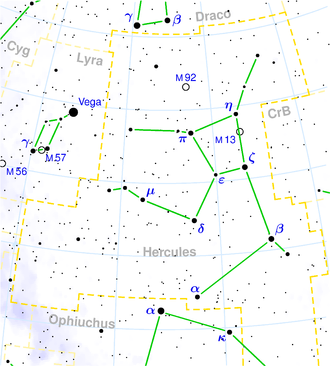Hercules (constellation)
Hercules is a constellation in the northern part of the sky. It represents the mythological Hercules of Greek mythology. It was one of the 48 constellations listed by an astronomer known as Ptolemy around the year 150 CE. It is now one of the 88 modern constellations on the International Astronomical Union's list.[1]
 Click for larger image | |
| List of stars in Hercules | |
| Abbreviation: | Her
genitive = Herculis |
| Genitive: | |
| Symbology: | |
| Right ascension: | 17h h |
| Declination: | +30°° |
| Area: | 1225 sq. deg. (5th) |
| Main stars: | 14, 22 |
| Bayer/Flamsteed stars: | 106 |
| Stars known to have planets: | 15 |
| Bright stars: | 2 |
| Nearby stars: | 9 |
| Brightest star: | β Her (Kornephoros) (2.78m) |
| Nearest star: | Gliese 661 ( ly) |
| Messier objects: | 2 |
| Meteor showers: | Tau Herculids |
| Bordering constellations: | Draco Boötes Corona Borealis Serpens Caput Ophiuchus Aquila Sagitta Vulpecula Lyra |
| Visible at latitudes between +90° and −50° Best visible at 21:00 (9 p.m.) during the month of July | |
Hercules (constellation) Media
The constellation Hercules as it may appear to the naked eye.
Traditional view of the Hercules constellation highlighting the quadrangle which forms the Keystone asterism.
An alternative way to connect the stars of the constellation Hercules, suggested by H.A. Rey. Here, Hercules is shown with his head at the top.
Hercules as depicted in Urania's Mirror, a set of constellation cards published in London c.1825. The figure appears upside down in the sky relative to neighbouring constellations. The former constellation of Cerberus is held by Hercules before its stars were part of the constellation.
References
- ↑ "Constellation". COSMOS - The SAO Encyclopedia of Astronomy. Retrieved 6 July 2019.



